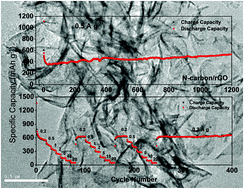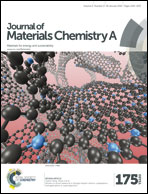Graphene/N-doped carbon sandwiched nanosheets with ultrahigh nitrogen doping for boosting lithium-ion batteries†
Abstract
Enhancing the nitrogen (N) doping in carbon nanomaterials has been suggested as an effective approach to enhance the performance of lithium ion batteries (LIBs). However, achieving N-doped carbon nanomaterials with an ultrahigh N content is still a great challenge, thus limiting the capacity enhancement. Herein, we demonstrate a new procedure for the synthesis of unique sandwich architecture of N-doped carbon/reduced graphene oxide (N-carbon/rGO) derived from simple pyrolysis of a polypyrrole/GO nanosheet precursor. The N-carbon/rGO exhibits the highest N-doping of 15.4% reported in all the carbon-based nanomaterials, and a high specific surface area of 327 m2 g−1 with a micro/mesoporous structure. They combine the advantages of high conductivity of rGO, very high N-functionalities, and the porous structure of carbons, which endow them with appealing electrochemical lithium storage properties with a high initial reversible capacity of 1100 mA h g−1 at 100 mA g−1, excellent rate capability up to 20 A g−1, and superior cycling stability over 1000 cycles at a high current density of 1 A g−1. The present work highlights the important role of tuning the nitrogen doping in enhancing the performance of LIBs.



 Please wait while we load your content...
Please wait while we load your content...